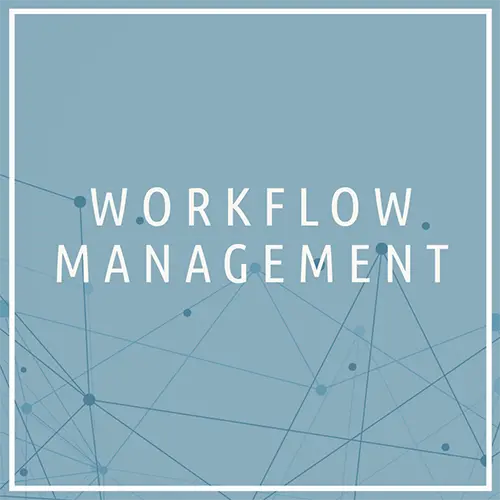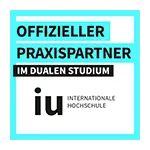What is a workflow?
The term “workflow” describes the interlinking of different, successive business processes within a company. A workflow is therefore also often referred to as a workflow plan. Workflows refer especially to subtasks within a project or a sub-area within a company. This means that different work processes follow one another in a systematic sequence.
A workflow is distinguished by the fact that it has a well-defined starting event and end result, and that it follows an organised sequence. In addition, a workflow must always serve a specific purpose and create a meaningful benefit, for example, internally for the company or externally for customers. For this purpose, several people employed in the company usually work on the different sub-steps in order to fulfil them.
A workflow can be illustrated as follows:
Best Practice – Workflow in the recruitment process
An example of a workflow that exists in every company is the recruitment process. This internal workflow, from the application of a candidate to the interview or even to the hiring, always follows a certain pattern. This pattern consists of different, successive workflows.
A company’s recruitment process could look like this:
- Drawing up the job advertisement for external applicants
- Checking the application documents received from the respective candidates
- Inviting suitable candidates for job interviews
- Internal coordination after the interviews
- Invitation of suitable candidates to a second interview
- Consultation with the management/human resources department
- Selecting a candidate and hiring the applicant
Although this workflow exists in every company, there are also differences everywhere. While one company consults with just one HR manager beforehand, another company has 3 HR managers involved right from the start. The processes would therefore look and run differently in these companies.
In addition, not every work step or workflow has to be considered linearly. It may well be that some sub-steps have to be repeated within an overall workflow. For example, it is unlikely that only one applicant will apply for the vacancy, be invited for an interview and then be allowed to fill the position. Rather, several applications have to be reviewed, evaluated and sorted out before the next step, the invitation to the interview, can be taken. Thus, a workflow can also be seen as a dynamic process within the company.
Workflow management and workflow management systems – IT-based applications in companies
Since a workflow is a business process that is often repeated in a company, it makes sense to structure, control and analyse these processes. This not only increases the effectiveness, but also the efficiency of the workflows and the employees working on them. Therefore, workflow management or workflow administration is always connected to the professional organisation and administration of workflows.
Workflow automation
In order to derive the greatest possible benefit from workflow management, it is worth investing in workflow software to establish a so-called workflow management system. This way, analogue data and workflows can run digitally, IT-supported. Especially the automation of these workflows, within the workflow management system, can create many advantages: Digital workflows can be perceived by employees as an enormous relief in their daily work. In detail, this is due to the fact that sources of errors are reduced, time is saved, processes are standardised and transparency is increased.
However, the technical automation in the workflow management system also reduces dynamism and flexibility, as work processes run according to predefined patterns. This in turn can have negative consequences for employees if they are chronically underchallenged by too many workflows or no longer understand important contexts. Companies should therefore always ensure that workflows are used sensibly.
The following business processes are often supported by electronic workflows:
- Invoice processing
- Approval processes
- Contract management
- Quality management
- Recruitment management
- Business trip applications
- Holiday application processes
- Incoming mail distribution
- Procurement requests
- Complaint management
Best Practice – IT workflows for leave requests
Holiday application processes are an essential, recurring component of work processes in the company. Therefore, the design of IT-based leave workflows is of interest to both large and small companies.
The processing of internal leave requests can look like this:
This example illustrates the chain of simultaneous processing and thus the dynamics of workflows for leave requests. Especially with recurring loops in the form of coordination processes and feedback rounds, rigid, linear structures do not work.
This is evident from the fact that in the upper chain, the leave would not have been approved because leave representative 1 rejected the substitution. However, since another holiday substitute was asked at the same time and said yes, the holiday request can go to the next step in the process and be presented to the supervisor. The supervisor then decides whether or not to approve the leave.
Workflow management with Microsoft SharePoint
One platform that stands for efficient workflow management is the Microsoft Power Platform. With the Microsoft Power Automate module (formerly known as “Flow”), technical processes can be automated and workflows created, such as the integration of an ERP system. The strengths of Microsoft Power Automate lie primarily in processes that do not require user interaction or participation.
With the Shareflex Flow component, which is integrated in all Shareflex applications, Portal Systems offers an in-house solution for workflow management. Shareflex Flow is based on SharePoint (Online), a service within Microsoft 365. It is ideally suited for the automation of individual parts or complete business processes where users are involved and have to make decisions, such as the approval of leave requests. Compared to Microsoft Power Automate, Shareflex Flow plays to its strengths in user involvement.
If you are interested in cloud-based workflow management and would like to optimise the business processes in your company, please contact us. We will help you find the right solutions to digitally support and advance your company.
Hamburg, January 26, 2022
Author: Sara Glöckner
Category: Business Wiki
You like what you read? Please feel free to share this article:








